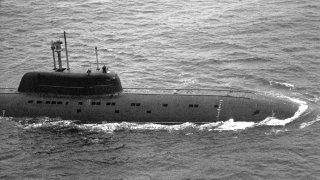Sub Crash: Russian 'Titanium' Submarine Slammed Into a Navy Los Angeles-Class Sub
In February 1992, the USS Baton Rouge, a Los Angeles-class submarine, collided with the Russian Kostroma near Severomorsk, just months after the Soviet Union's collapse.
What You Need to Know: In February 1992, the USS Baton Rouge, a Los Angeles-class submarine, collided with the Russian Kostroma near Severomorsk, just months after the Soviet Union's collapse.
-The collision, which occurred during a covert US intelligence mission, caused damage to both submarines, sparking diplomatic fallout between the US and the newly formed Russian Federation.
-While the Baton Rouge was retired due to repair costs, the Kostroma was repaired and remained in service.
-The incident highlighted ongoing Cold War tensions, despite the USSR’s dissolution, and forced the US to scale back some intelligence-gathering operations.
USS Baton Rouge vs. Russian Sub: The Underwater Collision That Shook the Post-Cold War Era
Throughout the Cold War, US and Soviet submarine forces engaged in a constant game of cat and mouse, an underwater chess match with implications for intelligence gathering, nuclear deterrence, and grand strategy. The game continued, however, after the fall of the Soviet Union, as one 1992 mishap proved.
The fall of the Soviet Union is indeed what inspired the Navy’s continued efforts to monitor Russian forces. The destabilization of the world order, the shift from bipolarity to unipolarity, had left the US with questions. Namely, what was the attitude of the new Russia? To what purpose would strategic assets, like a nuclear submarine force, be used?
On February 11th, 1992, the USS Baton Rouge, a Los Angeles-class nuclear attack submarine, was conducting a covert mission near Severomorsk, the Russian naval base. The Baton Rouge had been tasked with keeping a close eye on the Russian nuclear submarines to monitor for new developments. Well, the Baton Rouge got as close as one possibly can.
Confronting the enemy
At 8:16 pm local time, the Baton Rouge collided with the B-276 Kostroma, a Russian Sierra-class nuclear submarine. The collision occurred 12 miles from the shoreline, near Kildin Island. The true nature of the collision is unclear, with both countries making conflicting claims about the submarine activity being conducted. What appears to have happened, is that the Kostroma was surfacing, and struck the Baton Rouge from below, in the aft section.
“Pentagon disclosed yesterday that a U.S. submarine on an intelligence-gathering mission near the Russian port of Murmansk collided last week with a submarine operated by [Russia],” the Washington Post reported just after the incident. The Pentagon’s disclosure actually went against official policy at the time.
Both submarines were damaged. The Kostroma suffered a dented sail. The Baton Rouge suffered some minor damage to her port ballast tank. The real damage, however, was political. The Americans were shown to be conducting intelligence-gathering operations just miles from the shore of the newly formed Russia. Russian President Boris Yeltsin and US Secretary of State James Baker met following the collision.
The result of the conversation seems to be that the US agreed to stop tapping underwater cables. But not all that much could have changed. Barely one year later, on March 20th, 1993, the USS Grayling collided with the K-407 Novomoskovsk, again, near the Severomorsk naval base.
Anyways, after the 1992 incident, the Baton Rouge was written off; she never sailed again. The effort to repair the ship after the collision with Kostroma was deemed too expensive, especially given that the US was drawing down her forces after the conclusion of the Cold War. The Russians took pleasure in the Baton Rouge’s decommissioning, and are rumored to have notched the crippled ship as a victory for the Kostroma, complete with a “kill” marking on the submarine’s hull.
The Kostroma, meanwhile, is understood to still be in service today.
About the Author
Harrison Kass is a defense and national security writer with over 1,000 total pieces on issues involving global affairs. An attorney, pilot, guitarist, and minor pro hockey player, Harrison joined the US Air Force as a Pilot Trainee but was medically discharged. Harrison holds a BA from Lake Forest College, a JD from the University of Oregon, and an MA from New York University. Harrison listens to Dokken.'
Image Credit: Creative Commons.

